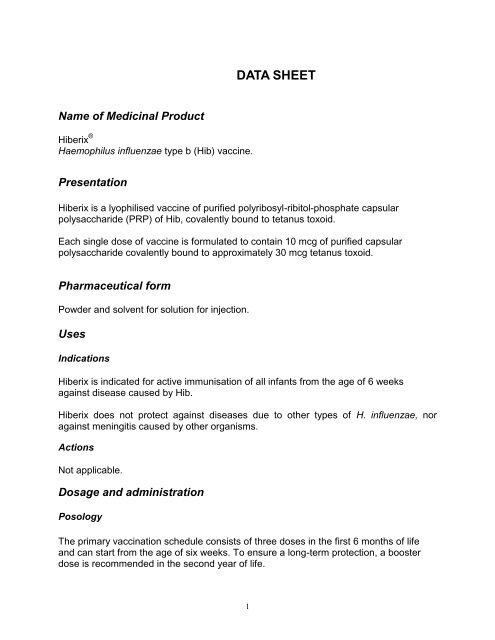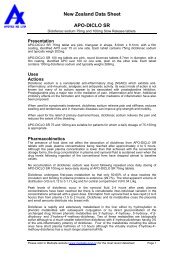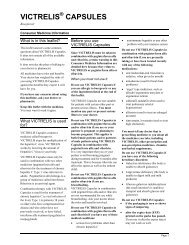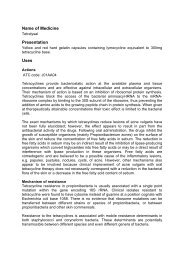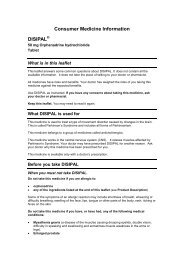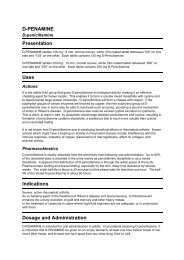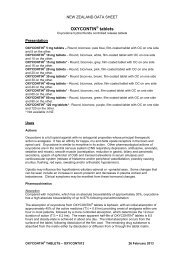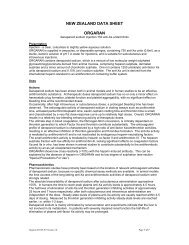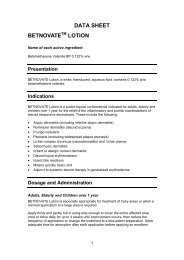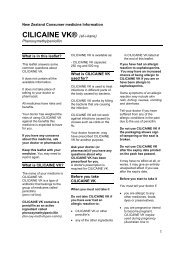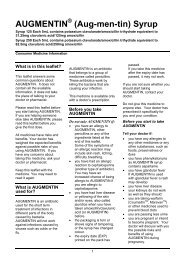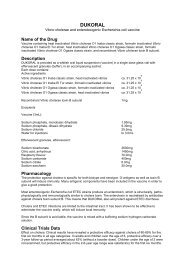Data Sheet - Medsafe
Data Sheet - Medsafe
Data Sheet - Medsafe
Create successful ePaper yourself
Turn your PDF publications into a flip-book with our unique Google optimized e-Paper software.
DATA SHEET<br />
Name of Medicinal Product<br />
Hiberix ®<br />
Haemophilus influenzae type b (Hib) vaccine.<br />
Presentation<br />
Hiberix is a lyophilised vaccine of purified polyribosyl-ribitol-phosphate capsular<br />
polysaccharide (PRP) of Hib, covalently bound to tetanus toxoid.<br />
Each single dose of vaccine is formulated to contain 10 mcg of purified capsular<br />
polysaccharide covalently bound to approximately 30 mcg tetanus toxoid.<br />
Pharmaceutical form<br />
Powder and solvent for solution for injection.<br />
Uses<br />
Indications<br />
Hiberix is indicated for active immunisation of all infants from the age of 6 weeks<br />
against disease caused by Hib.<br />
Hiberix does not protect against diseases due to other types of H. influenzae, nor<br />
against meningitis caused by other organisms.<br />
Actions<br />
Not applicable.<br />
Dosage and administration<br />
Posology<br />
The primary vaccination schedule consists of three doses in the first 6 months of life<br />
and can start from the age of six weeks. To ensure a long-term protection, a booster<br />
dose is recommended in the second year of life.<br />
1
Infants between the ages of 6 and 12 months previously unvaccinated should receive 2<br />
injections, given with an interval of one month, followed by a booster in the second year<br />
of life. Previously unvaccinated children aged 1-5 years should be given one dose of<br />
vaccine.<br />
Method of administration<br />
The reconstituted vaccine is for intramuscular injection. However, it is good clinical<br />
practice that in patients with thrombocytopenia or bleeding disorders the vaccine should<br />
be administered subcutaneously.<br />
Contra-indications<br />
Hiberix should not be administered to subjects with known hypersensitivity to any<br />
component of the vaccine, or to subjects having shown signs of hypersensitivity after<br />
previous administration of Hib vaccines.<br />
Special warnings and special precautions for use<br />
As with other vaccines, the administration of Hiberix should be postponed in subjects<br />
suffering from acute severe febrile illness. The presence of a minor infection, however,<br />
is not a contra-indication for vaccination.<br />
As with all injectable vaccines, appropriate medical treatment and supervision should<br />
always be readily available in case of a rare anaphylactic event following the<br />
administration of the vaccine.<br />
Human Immunodeficiency Virus (HIV) infection is not considered as a contra-indication<br />
for Hiberix.<br />
Although limited immune response to the tetanus toxoid component may occur,<br />
vaccination with Hiberix alone does not substitute for routine tetanus vaccination.<br />
Excretion of capsular polysaccharide antigen in the urine has been described following<br />
receipt of Hib vaccines, and therefore antigen detection may not have a diagnostic<br />
value in suspected Hib disease within 1-2 weeks of vaccination.<br />
Hiberix should under no circumstances be administered intravenously.<br />
The potential risk of apnoea and the need for respiratory monitoring for 48 to 72 hours<br />
should be considered when administering the primary immunization series to very<br />
premature infants (born ≤ 28 weeks of gestation) and particularly for those with a<br />
previous history of respiratory immaturity. As the benefit of vaccination is high in this<br />
group of infants, vaccination should not be withheld or delayed.<br />
2
Syncope (fainting) can occur following, or even before, any vaccination as a<br />
psychogenic response to the needle injection. It is important that procedures are in<br />
place to avoid injury from faints.<br />
Interaction with other medicaments and other forms of interaction<br />
Hiberix can be administered either simultaneously or at any time before or after a<br />
different inactivated or live vaccine.<br />
Hiberix can be mixed in the same syringe with GlaxoSmithKline vaccine Infanrix ® (DTPa<br />
vaccine). Other injectable vaccines should always be administered at different injection<br />
sites.<br />
As with other vaccines it may be expected that in patients receiving immunosuppressive<br />
therapy or patients with immunodeficiency, an adequate response may not be<br />
achieved.<br />
Pregnancy and lactation<br />
Pregnancy<br />
Adequate human data on use during pregnancy and adequate animal reproduction<br />
studies are not available.<br />
Lactation<br />
Adequate human data on use during lactation and adequate animal reproduction<br />
studies are not available.<br />
Effects on ability to drive and use machines<br />
Not applicable.<br />
Adverse effects<br />
In controlled clinical studies, signs and symptoms were actively monitored and recorded<br />
on diary cards following the administration of the vaccine.<br />
Of the local solicited symptoms the most frequently reported within the first 48 hours<br />
was mild redness at the injection site which resolved spontaneously. Other local<br />
solicited symptoms reported were mild swelling and pain at the injection site.<br />
3
The general symptoms which have been solicited and reported within the first 48 hours<br />
were mild and resolved spontaneously. These include fever, loss of appetite,<br />
restlessness, vomiting, diarrhoea and unusual crying. As for all Hib vaccines, these<br />
general symptoms have been also reported when administered concomitantly with<br />
other vaccines.<br />
Post Marketing <strong>Data</strong><br />
Undesirable effects reported are listed according to the following frequency:<br />
Very rare 0.15 mcg/ml was obtained in 95-100% of infants one month after the<br />
completion of the vaccination course. A titre of > 0.15 mcg/ml was obtained in 100% of<br />
infants one month after the booster dose (94.7% with a titre of > 1.0 mcg/ml).<br />
Pharmacokinetics<br />
Evaluation of pharmacokinetic properties is not required for vaccines.<br />
Pharmaceutical precautions<br />
Not applicable.<br />
4
List of excipients<br />
Vaccine : lactose<br />
Diluent : sterile saline solution<br />
Incompatibilities<br />
Hiberix can be mixed in the same syringe with GlaxoSmithKline vaccine Infanrix ® (DTPa<br />
vaccine)). Other injectable vaccines should always be administered at different<br />
injection sites.<br />
Hiberix should not be mixed with other vaccines in the same syringe (except for<br />
authorised combinations).<br />
Shelf-life<br />
The expiry date of the vaccine is indicated on the label and packaging.<br />
When stored under prescribed conditions, the shelf-life is 36 months.<br />
Special precautions for storage<br />
The lyophilised vaccine has to be stored at +2°C to +8°C. The lyophilised vaccine is<br />
not affected by freezing.<br />
The diluent can be stored in the refrigerator (at +2°C to +8°C) or at ambient<br />
temperatures (up to 25°C) and should not be frozen.<br />
Nature and contents of container<br />
The lyophilised vaccine is presented as a white pellet in a glass vial.<br />
The sterile diluent (saline) is clear and colourless and presented in a glass vial or<br />
prefilled syringe.<br />
The vials and syringes are made of neutral glass type I, which conforms to European<br />
Pharmacopoeia Requirements.<br />
Instructions for use/handling<br />
The diluent and reconstituted vaccine should be inspected visually for any foreign<br />
particulate matter and/or variation of physical aspects prior to administration. In the<br />
event of either being observed, discard the diluent or reconstituted vaccine.<br />
The vaccine must be reconstituted by adding the entire contents of the supplied<br />
container of diluent to the vial containing the pellet. After the addition of the diluent to<br />
5
the pellet, the mixture should be well shaken until the pellet is completely dissolved in<br />
the diluent.<br />
After reconstitution, the vaccine should be injected promptly.<br />
Hiberix may be mixed with Infanrix ® vaccine. In this case, the diluent supplied in the<br />
Hiberix package is replaced by the liquid vaccine.<br />
Other Information<br />
The Hib polysaccharide is prepared from Hib, strain 20,752 and after activation with<br />
cyanogen bromide and derivatisation with an adipic hydrazide spacer is coupled to<br />
tetanus toxoid via carbodiimide condensation. After purification the conjugate is<br />
lyophilised in the presence of lactose as stabiliser.<br />
Hiberix meets the WHO requirements for manufacture of biological substances and of<br />
Hib conjugated vaccines.<br />
Medicine Classification<br />
Prescription Medicine<br />
Package Quantitites<br />
Pack of one vial of lyophilised vaccine and one vial of diluent<br />
Pack of one vial of lyophilised vaccine and one pre-filled syringe of diluent<br />
Pack of 10 vials of lyophilised vaccine and 10 pre-filled syringes of diluent<br />
Name and Address<br />
GlaxoSmithKline NZ Ltd<br />
AMP Centre<br />
Cnr Albert & Customs Street<br />
Private Bag 106600<br />
Downtown<br />
Auckland<br />
NEW ZEALAND<br />
ph (09) 367 2900<br />
fax (09) 367 2910<br />
Date of Preparation<br />
7June 2011<br />
Hiberix ® and Infanrix ® are registered trade marks of the GlaxoSmithKline group of companies.<br />
6
Version 4.0<br />
7


